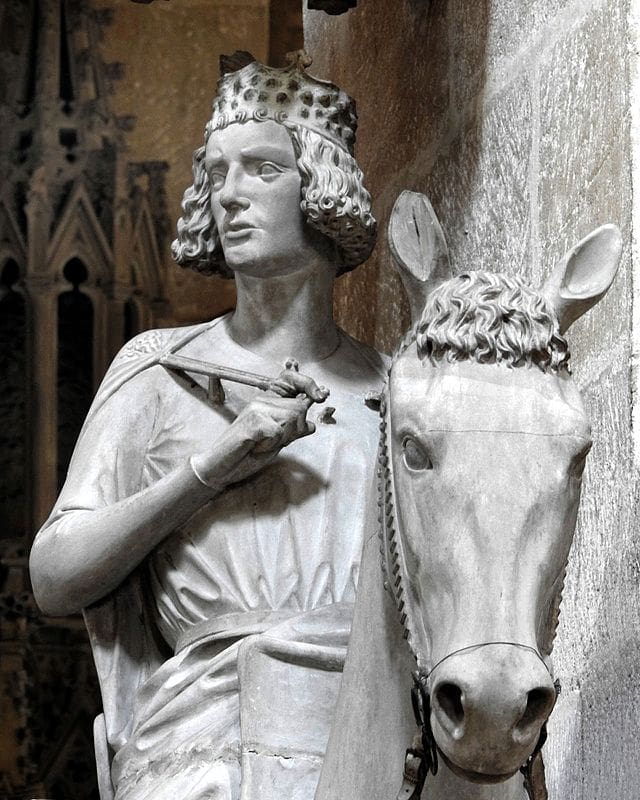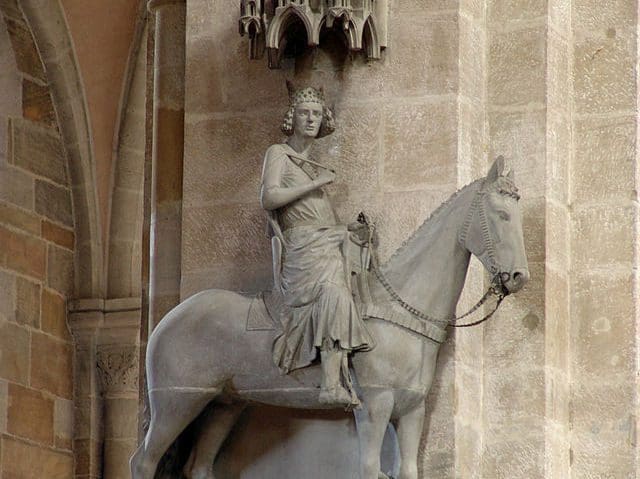In his book Bamberg Myths and Legends published in 1842, a college professor from Bamberg wrote about the Hungarian King St Stephen (1000–1038) riding into the Bamberg Cathedral. An equestrian statue can still be found in the cathedral today, which, according to a widespread belief, depicts the Hungarian king who was canonised in 1083.[1]
But how did St Stephen end up at Bamberg? Bamberg, located 800 kilometres from Budapest, is today a city in Upper Franconia, Germany. Its name comes from the name of the Babenberg dynasty, known from Austrian history, as the area fell into the hands of the Bavarian princes only at the turn of the millennium. From then on, the story becomes even more exciting: Henry II, Holy Roman Emperor (1002–1024) was originally a Bavarian prince, and a few years after he ascended the throne, in 1007, he founded a new bishopric in Bamberg.
By this time, German–Hungarian relations had been flourishing for years, after Gisela of Bavaria, the sister of Henry, who had been the Bavarian prince at the time, became the wife of the then Hungarian prince Stephen in the 990s. According to medieval Hungarian chroniclers, St Stephen led Hungary’s conversion to Christianity and the establishment of the Church body. However, German chroniclers had a slightly different understanding of the story: they attributed the merit of converting the country to Christianity to Queen Gisela’s German escort and her brother Henry. In the modern era, when history was reimagined in Germany, from this train of thought it logically followed that Stephen, who had still been a ‘pagan’ at the time, had to be baptised before the wedding. And where else could this have taken place than in the Bamberg Cathedral founded by Henry II? Of course, the cathedral was not yet standing at the time of the marriage, and Stephen, as far as we know, never left the territory of Hungary, but reality never bothered mythmakers. St Stephen’s baptism in Bamberg and his marriage were first mentioned by Jakob Ayrer, a German poet, around 1600. According to his story, Henry II defeated his pagan opponent, Stephen, in a battle, and then took him to Bamberg with him, where during the dedication of the Bamberg Cathedral in 1012, Pope Benedict VIII baptised him and married him to Gisela.[2]
Despite the considerable distance, Bamberg indeed played a role in Hungarian history.
Hungary’s primate, the Archbishop of Esztergom, also attended the ground-breaking ceremony (1007) and the dedication (1012) of the Bamberg Cathedral founded by Henry. In addition, Bishop Eckbert of Meran (1203–1237), who had the cathedral rebuilt at the beginning of the 13th century, was closely connected to Hungary as well, since he was the brother of the German wife of Andrew II of Hungary (1205–1235), and he even accompanied the Hungarian king on the Fifth Crusade in 1217. In the treasury of the cathedral, we can find the relics of the Holy Kings of Hungary. Moreover, in 1333, the provost of Bamberg prayed to St Stephen for help in an armed conflict—not without results. And he did so on 20 August of all dates, even though that day was the remembrance day of St Bernard of Clairvaux (1090–1153), canonised in 1174, who can be considered much more of a knight saint that St Stephen. It was well known that Bernard had participated in the publicization of the Second Crusade and had also written In Praise of the New Knighthood for the Knights Templar.
The more than two-metre-high equestrian statue in the Bamberg Cathedral has been a real tourist attraction since the 18th century, not least due to the horseman’s mysterious identity. We do not know exactly when the statue was completed, nor when it was placed in its current location. Art historians rightly associate the statue with the reconstruction of the cathedral in the first third of the 13th century. However, it would be easier to find out more about the horseman’s identity had he been mentioned in medieval descriptions as well—they would reveal who the contemporaries believed him to be, but unfortunately, there are no allusions to the equestrian figure’s identity. In fact, there are no symbols or written words that could serve as clues on the statue itself either, apart from a schematic crown—which is a shame, because at that time it was not usual to place equestrian statues in the liturgical space of churches, even if they were saints.

The first description attempting to identify the horseman with St Stephen dates back to 1725, when a German doctor and traveller, Franz Ernst Brückmann, recorded his visit to Bamberg. The identity of the author is no accident, as he had visited Hungary before and was also seriously interested in the Hungarian Holy Crown—he certainly had an affinity with Hungarian history. According to his description, the statue depicts Saint Stephen, the brave king of Hungary, at the moment he rode into Bamberg on his fiery horse to visit Henry II.[3] What is certain is that what the traveller recorded in 1725 was a long-known local Bamberg legend. From then on,
the local people’s conviction that the statue represented the Hungarian king remained unbroken
—until critical historiography appeared at the end of the 19th century. Since then, critical voices have rightly asked the question : why should we assume that the horseman features a Hungarian king, when Henry II, the founder of the cathedral, canonised in 1147, as well as Conrad III of Germany, who led the Second Crusade, are buried in the church. Other suggestions as to the identity of the statue include the co-patron of the cathedral, a ‘real’ equestrian saint, George; one of the three Magi; Emperor Constantine the Great; Frederick II, Holy Roman Emperor, who peacefully reconquered Jerusalem in 1229, but was repeatedly excommunicated by the Pope; and even the Messiah himself. The trope of Hungarians as horsemen was also often used as an argument in support of the identification of the statue with a Hungarian—if he is sitting on a horse, he must be Hungarian!
Given that the statue is probably not in the same place as it used to be at the beginning of the 13th century, we will never know its original identity with absolute certainty. The lack of parallels in medieval art history suggests that originally, it was not a specific worldly ruler that was intended to be represented. The statue may have formed part of a larger group of statues, perhaps of a rod screen type, of which only fragments have survived due to reconstructions.[4]
Then, under Nazism, the statue was—unexpectedly—made a symbol of the Aryan Germanic race, despite the fact that the Bamberg horseman’s face bears a striking resemblance to one of the royal statues decorating the Reims Cathedral in France. Therefore, the equestrian statue’s identification with the Hungarian king during World War II was interpreted as an opposition to fascist views, something that the bishops of Bamberg took the lead in. Meanwhile, in Hungary, the anniversary of the king’s death was celebrated in 1938, a year that was then declared St Stephen’s Memorial Year. Hungarian publications of the time stated that the statue ‘embodies the admiration of the German people for the princely bridegroom who married the princess…’—however, they did not take note of the fact that the official German perception around this time was just the opposite, as it was believed that the statue has the physiognomy of Parsifal, the ‘eternal German’.
The revival of interest in Hungary as a result of the anti-Ottoman wars of the 17th century may have played a role in the development of the Bamberg tradition and in the identification of the statue with the Hungarian king. Hungary was the most important battlefield of the clash between Christians and the Ottoman Empire. The plays staged in Jesuit schools clearly demonstrate the interest in Hungary and St Stephen: between 1575 and 1773, Hungarian historical plays were continuously performed—in Bamberg alone, three were presented, and the subject of all of them was King Stephen.[5]
So the truth is that Saint Stephen never rode into Bamberg. It was the people of Bamberg who reimagined the figure of the Hungarian Holy King and literally incorporated him into their own tradition. They certainly thought that identifying the statue with the Hungarian king, who was becoming quite popular at the time, would increase the prestige and influence of the cathedral. In any case, from the 18th century onwards, we can be certain that the equestrian statue was regarded as a depiction of the Hungarian Holy King St Stephen—we just do not know when exactly the identification took place.
[1] Assaf Pinkus, ‘Imagining the Magdeburg Rider’, Paragrana, Vol. 23, No. 1, 2014, pp. 23–45.
[2] Anja Grebe, ‘Der Bamberger Reiter im Kontext der mittelalterlichen Reiterskulptur’, in Stephan Albrecht (ed.), Der Bamberger Dom im europäischen Kontext, Bamberg, 2015, p. 196.
[3] Franz-Ernst Brückmann, Epistola itineraria octava sistens Memorabilia Bambergensia, Wolfenbüttel, 1729, p. 3.
[4] Dorothea Diemer, ‘Der Reiter und Kindheit–Christi-Szenen für den Ostlettner. Neue Überlegungen zur Skulptur im Bamberger Dom’, Zeitschrift des deutschen Vereins für Kunstwissenschaft, Vol. 68, 2014, pp. 137–146.
[5] Georg Schreiber, ‘König Stephan der Heilige in der deutschen Hagiographie und im Schuldrama’, Zeitschrift für katholische Theologie, Vol. 62, 1938, pp. 502–536.







